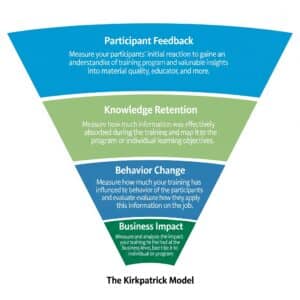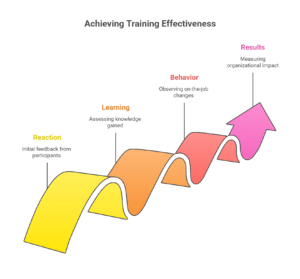Introduction to Training Evaluation Models
In today’s highly competitive business landscape, organizations recognize that investing in employee training and development is vital for sustained growth and success. However, simply implementing training programs is not enough; measuring their effectiveness is essential to ensure they deliver real value.
Training evaluation models are crucial tools that help organizations systematically and objectively assess the impact of their Learning and Development (L&D) initiatives.
Effective training evaluation allows organizations to determine if learning objectives are achieved, skills are enhanced, and overall performance improves. It also provides insights into return on investment (ROI) and informs future training strategies. Choosing the right evaluation model is critical because different models offer various perspectives and levels of analysis, from immediate reactions to long-term business outcomes.
Understanding these models enables organizations to tailor assessments to their specific goals, demonstrate accountability, and foster continuous improvement in their training efforts.
In this section, we highlight the importance of training evaluation models, explaining why selecting the appropriate approach is fundamental for accurately measuring the impact of L&D initiatives and ensuring organizational success.
What is Kirkpatrick Model
The Kirkpatrick Model is a widely used framework for evaluating the effectiveness of training programs.
It consists of four levels:
-
Reaction – Measures how participants feel about the training.
-
Learning – Assesses the knowledge and skills gained during the training.
-
Behavior – Evaluates how well participants apply what they learned in the workplace.
-
Results – Determines the overall impact of the training on organizational outcomes, such as productivity or performance.
The model helps organizations understand the effectiveness of their training programs at multiple stages, from initial impressions to long-term results.

Understanding that these levels are hierarchical yet interconnected helps organizations diagnose gaps. For instance, high satisfaction scores without behavioral change or results suggest content or support issues.
A holistic approach ensures training aligns with business goals and is evaluated comprehensively.
Comparing the Kirkpatrick Model with Other Evaluation Frameworks
Effective training evaluation hinges on reliable frameworks that accurately measure outcomes and guide decisions. The Kirkpatrick Model is among the most popular, but alternative frameworks such as the Phillips ROI Methodology and the CIPP (Context, Input, Process, Product) Model also offer unique advantages suited to specific organizational needs. This section compares these frameworks, outlining their strengths, limitations, and ideal applications.
The Kirkpatrick Model: Overview and Strengths
Developed in the 1950s by Donald Kirkpatrick, this model emphasizes a four-level approach:
- Reaction: Participant satisfaction and engagement.
- Learning: Knowledge and skill acquisition.
- Behavior: Changes in workplace practices.
- Results: Organizational impact and ROI.
Strengths:
– Its simplicity and ease of use make it accessible for most organizations.
– It offers a clear pathway from participant feedback to organizational results.
– Its extensive empirical support ensures reliability.
Limitations:
– It may overemphasize soft metrics like satisfaction, which don’t always translate into improved performance.
– Measuring behavior change and linking it to results can be challenging without longitudinal data.
– It lacks a direct focus on financial ROI, limiting strategic decision-making.
The Phillips ROI Model: Focused on Financial Outcomes
Building on Kirkpatrick’s framework, Jack Phillips introduced the ROI Methodology, which highlights financial metrics:
- Incorporates Kirkpatrick’s four levels but adds ROI.
- Uses systematic statistical analysis to quantify financial benefits relative to costs.
Strengths:
– Provides a tangible, monetary measure of training effectiveness.
– Supports informed investment decisions by demonstrating actual ROI.
– Promotes rigorous data collection and analysis.
Limitations:
– Resource-intensive, requiring expertise and substantial data gathering.
– Less suitable when financial metrics are difficult to quantify or not the primary focus.
– May overlook qualitative benefits, such as employee morale or brand reputation.
The CIPP Model: Comprehensive Evaluation Approach
Developed by Daniel Stufflebeam, the CIPP Model emphasizes continuous improvement:
- Context: Identifies needs and opportunities.
- Input: Assesses resources and strategies.
- Process: Monitors implementation fidelity.
- Product: Measures outcomes and impacts.
Strengths:
– Emphasizes formative evaluation and ongoing feedback for real-time adjustments.
– Provides a holistic view covering organizational, procedural, and outcome factors.
– Highly adaptable across various sectors.
Limitations:
– Can be complex and time-consuming to implement effectively.
– Less focused on financial ROI unless explicitly integrated.
– Requires skilled evaluators for proper design and interpretation.
Application Scenarios and Suitability
While Kirkpatrick provides a practical and validated approach, combining it with frameworks like Phillips ROI and CIPP can offer a richer, more comprehensive view. Organizations should select the most appropriate methodology based on goals, resources, and needs. Solutions like Paradiso LMS integrate various evaluation tools—including ROI calculations—supporting strategic decision-making and improved training outcomes.
🚀 Ready to See Paradiso LMS in Action?
Let’s show you how Paradiso LMS can work for you.
| Framework | Ideal For | Limitations |
|---|---|---|
| Kirkpatrick | Organizations seeking straightforward, multi-level evaluation; emphasis on participant feedback and behavior | Limited focus on ROI; may oversimplify complex impacts |
| Phillips ROI | Organizations needing precise financial justification; programs with measurable tangible results | Resource-heavy; best for financially driven evaluation |
| CIPP | Organizations prioritizing continuous improvement; programs needing formative evaluation | Potentially resource-intensive; less focus on financial ROI |
Practical Applications and Case Studies
The Kirkpatrick Model’s widespread use spans numerous industries, with real-world examples demonstrating its effectiveness. These case studies showcase how tailored application of this framework can enhance learning outcomes, measure ROI, and inform continuous improvement.
Corporate Sector: Boosting Sales Performance
A global retail firm aimed to improve its sales team’s effectiveness through targeted training. Using the Kirkpatrick Model, they evaluated each level:
- Reaction: Post-training surveys showed 85% of participants felt more confident and satisfied.
- Learning: Pre- and post-assessments reflected a 30% increase in product knowledge scores.
- Behavior: Three months later, managers observed more customer engagement and upselling behaviors.
- Results: Sales revenue increased by 15%, and customer satisfaction scores improved—a clear link to training impact.
Healthcare: Improving Patient Care
A hospital implemented a nurse training program on infection control. Applying Kirkpatrick:
- Reaction: Nurses reported increased confidence and felt more valued.
- Learning: Knowledge tests showed a 25% improvement in protocol adherence.
- Behavior: Observations revealed a 20% reduction in infection rates over six months.
- Results: Cost savings from fewer hospital-acquired infections and improved patient outcomes validated training effectiveness.
Best Practices for Effective Evaluation
To maximize training evaluation success, organizations should:
- Define Clear Objectives: Set measurable goals aligned with evaluation levels.
- Use Mixed Methods: Combine quantitative data with qualitative insights for comprehensive understanding.
- Plan Evaluation from the Start: Incorporate assessment strategies during program design.
- Engage Stakeholders: Involve managers and learners in the evaluation process.
- Leverage Technology: Employ LMS features to facilitate data collection and analysis.
Addressing Challenges:
- Linking Training to Results: Use controls and baselines for causality.
- Resistance to Evaluation: Communicate benefits clearly.
- Limited Resources: Prioritize critical levels and utilize existing data.
By applying these practices, organizations can turn training into a strategic asset for ongoing growth and improvement. Solutions like Paradiso LMS support effective evaluation through integrated tracking, analytics, and reporting features.
Enhancing Training Evaluation with Paradiso LMS
Effective training evaluation is essential for measuring program success and impact. Paradiso LMS simplifies this process through comprehensive tools that facilitate multi-level assessment aligned with the Kirkpatrick Model. This integration ensures organizations can accurately measure learner satisfaction, knowledge retention, behavioral changes, and ROI—driving strategic improvements.
Supporting Multi-Level Evaluation Aligned with Kirkpatrick
As established, the Kirkpatrick Model evaluates training at four levels:
– Reaction
– Learning
– Behavior
– Results
Paradiso LMS’s features are designed to seamlessly support each level, providing a complete view of training effectiveness.
Level 1: Learner Satisfaction/ Reaction
The platform includes intuitive survey tools integrated into courses. After training, learners can easily provide feedback on content relevance and engagement. Customizable forms ensure tailored questions, and real-time data collection enables prompt improvements.
Level 2: Knowledge Assessment/ Learning
Paradiso LMS offers assessments like quizzes, tests, and certifications—automatically graded and stored for analysis. These tools help measure knowledge gains, identify gaps, and adapt content accordingly. Dashboards display performance trends for quick insights.
Level 3: Behavioral Change/ Behavior
The system supports ongoing tracking through post-training performance metrics, manager feedback, and skill assessments. Combining this with performance management integration helps monitor how learning translates into workplace behavior.
Level 4: ROI Calculation/ Results
The platform provides detailed analytics consolidating data across levels. With comprehensive reports, organizations can analyze productivity increases, error reductions, customer satisfaction improvements, and other KPIs—enabling precise measurement of training ROI.

Actionable Data and Decision-Making
Paradiso LMS’s advanced analytics dashboards empower training managers to monitor progress continuously, identify gaps, and demonstrate value to stakeholders. By correlating evaluation data with organizational performance, companies can make informed decisions for future initiatives.
In summary, integrating the Kirkpatrick Model within Paradiso LMS enhances training evaluation, supporting data-driven growth and strategic planning.
Conclusion: Making Informed Decisions in Training Evaluation
Effective training evaluation is fundamental to understanding learning impacts, ROI, and ongoing enhancement of programs. As discussed, selecting the right evaluation methodology depends on organizational objectives, resource capacity, and the depth of data required.
The Kirkpatrick Model’s four levels—Reaction, Learning, Behavior, and Results—serve as a valuable foundation for comprehensive assessment. While reaction surveys are straightforward, deeper evaluations at higher levels provide richer insights into actual learning application and organizational impact. Combining various methods tailored to strategic goals results in a more holistic understanding of training effectiveness.
Incorporating innovative data collection techniques—such as digital analytics and performance metrics—can improve accuracy and relevance. Establishing clear benchmarks from the outset allows for better measurement and tracking over time.
Leveraging integrated Learning Management Systems like Paradiso LMS simplifies data gathering, analysis, and reporting. Such tools make ongoing evaluation more feasible, providing actionable insights that drive strategic decisions, increase ROI, and foster continuous improvement.
By adopting a thoughtful, informed approach to training evaluation, organizations ensure their learning investments deliver measurable value, contribute to business success, and support a culture of ongoing development.

















